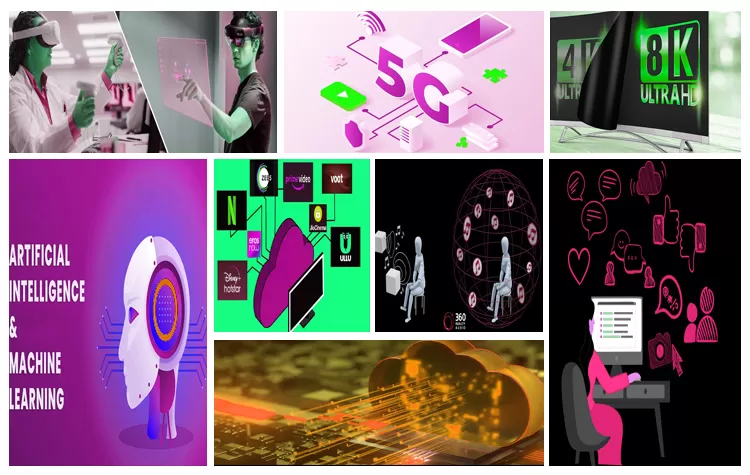So, sports broadcasting in the future will eventually hang on the rapid pace of technological changes that can bring about a completely immersive, interactive, and personalized experience for fans. Some of the main innovations that will help shape this future are the following:
1. Virtual Reality (VR) and Augmented Reality (AR)
- Virtual reality broadcasting: The virtual reality network allows fans to follow sports in 360-degree coverage. Fans can therefore feel the live action as if they are seated courtside or front-row, which means that the experience becomes more engaging and personal.
- AR enhancements: Overlays of reality, including actual real-time statistics, player tracking, and tactical outlooks become regular features in broadcasts. Such features add information and depth to the games and make them more entertaining.
2. 5G Connectivity
- Faster streams: Through 5G, the streams are of good quality and minimum latency, thus availing real-time streaming of multi-angle coverage, instant replays, among others.
- Enhanced Mobile Viewing: Through 5G connectivity, fans can stream high-definition content on smartphones and tablets even in crowded venues.
3. Artificial Intelligence and Machine Learning
- AI Highlights: With AI systems, the creation of highlights and review of game footage can be achieved almost in real time while also helping to streamline the production of instant replays and summaries which can then be broadcast. AI-powered data analytics also provide more in-depth insights into the ways a player or a team could perform and even the strategies that are being developed.
- Personalized viewing experiences: With machine learning, the broadcasters can personalize the experience of each fan to offer correct notification, commentary, and camera angles of a favorite player or team.
4. Cloud-based broadcasting
- Remote production: It will be possible with cloud technologies to manage from other places, meaning live event productions will be managed from other places than from where the events are taking place. It might require fewer large crews on site and thus increase flexibility and reduce the costs of productions. As a result, it is easier to cover global sports events.
- Scalability and efficiency: Cloud-based solutions give easy scalability to broadcasters' operations so that they can hold broadcasts on major events like the Olympics or World Cup without much infrastructure.
5. Interactive and Social Features
- Fan engagement: Integrating social media feeds, live polls, and interactive chats into the broadcasts engage fans in seeing how others are viewing and discussing the game.
- Second-screen experiences: The broadcaster is developing apps that are not only an extension of the main broadcast but also provide ancillary information, interactivity, and real-time fantasy sports data.
6. Advanced Analytics and Data Visualization
- Integration with real-time data - Wearable technology and player tracking gives real-time data on player speed, fatigue level, etc. It can enhance the experience of viewers with more in-depth insights.
- Richer graphics: The programs will enable more vivid visualizations for advanced statistics and trend analysis, making it easier for a new fan or viewer to follow along who do not have to know as much about the sport.
7. 4K and 8K Ultra High-Definition (UHD) Streaming
- Better picture quality: With 4K and 8K streaming, users will be able to see a kind of detail that was never witnessed before, making games more entertaining by capturing everything from ball spin to facial expressions of the players
- High Dynamic Range (HDR) - Used together with UHD streaming, it will offer brighter colors, a higher contrast level than before, and enhance the visual quality of live sports events.
8. OTT Platforms and Streaming Services
- Direct-to-consumer streaming: The increasingly common use of over-the-top or over-the-air streaming platforms such as ESPN+, DAZN, and Amazon Prime provides the basis for the football fan's personal preference in regards to how and when they access their game through choices such as the on-demand.
- Bundling/unbundling of sports content: It will soon be possible to pay for individual games or teams or leagues, hence changing the order of the cable bundle.
9. 3D Immersive Audio and Spatial Sound
- With spatial sound technology, 3D audio heightens the audio experience so that the viewer feels a roar of the crowd and an impact of the ball as if he were inside the stadium with sounds all around.
- Customizable audio feeds: The broadcasters are looking at ways the viewers can customize the audio experience they want, like listening to stadium sounds without commentary or a different commentary team.
10. Esports and Virtual Competitions
- Esports broadcasting continues to grow: Esports continues to explode, with streaming platforms and large-scale events competing with traditional sports. As younger demographics shift their attention to gaming, mainstream networks are expected to continue integrating esports.
- Virtual sports simulations: Emergence of deep realism in sports simulations thanks to AI and game development, and therefore, an innovative medium to interact with the relationship between broadcasters and their fans, particularly at times when an off-season begins or where a series of live events gets canceled.
Conclusion
The future of sports broadcasting is becoming immersive, interactive, and personalized. The revolutions in VR, AI, 5G, and UHD streaming redefine what will seem like a totally new game while watching sports: that is, there will be thrilling excitement that one has never experienced before.
